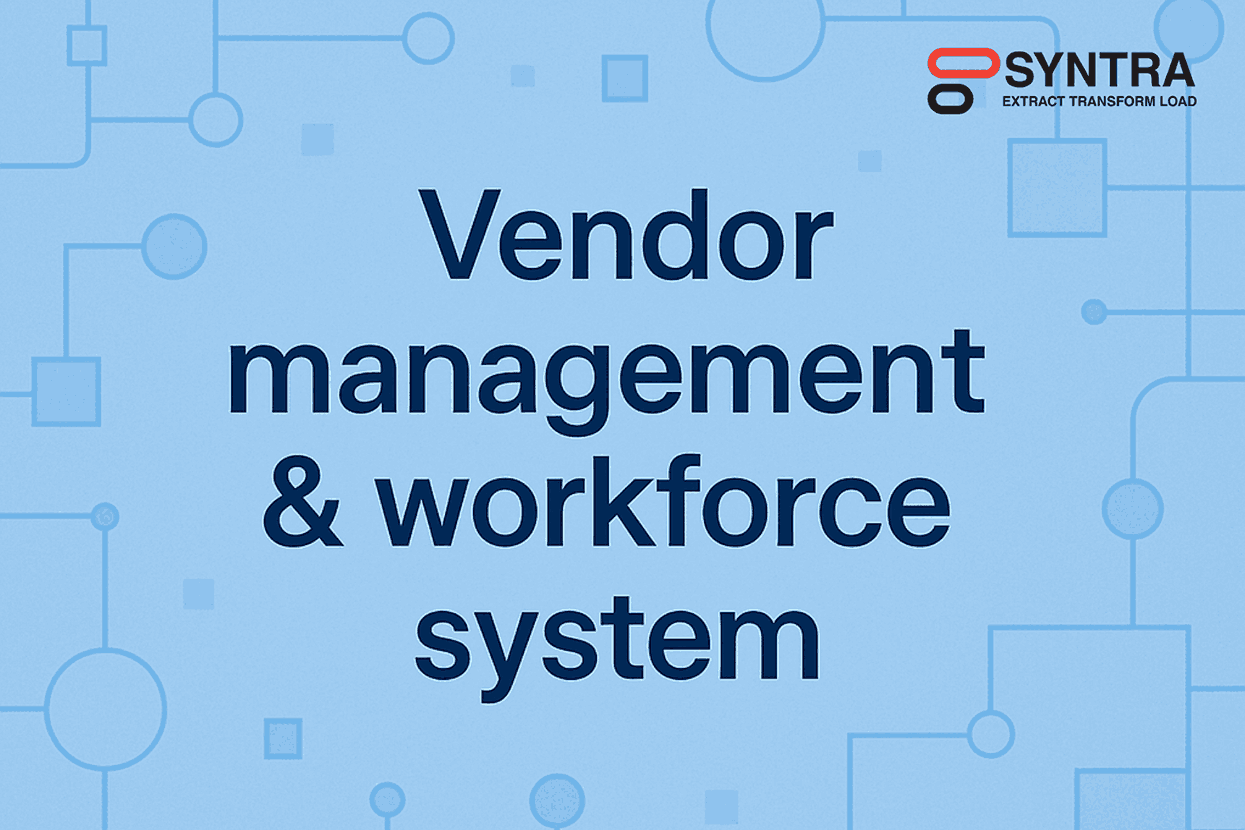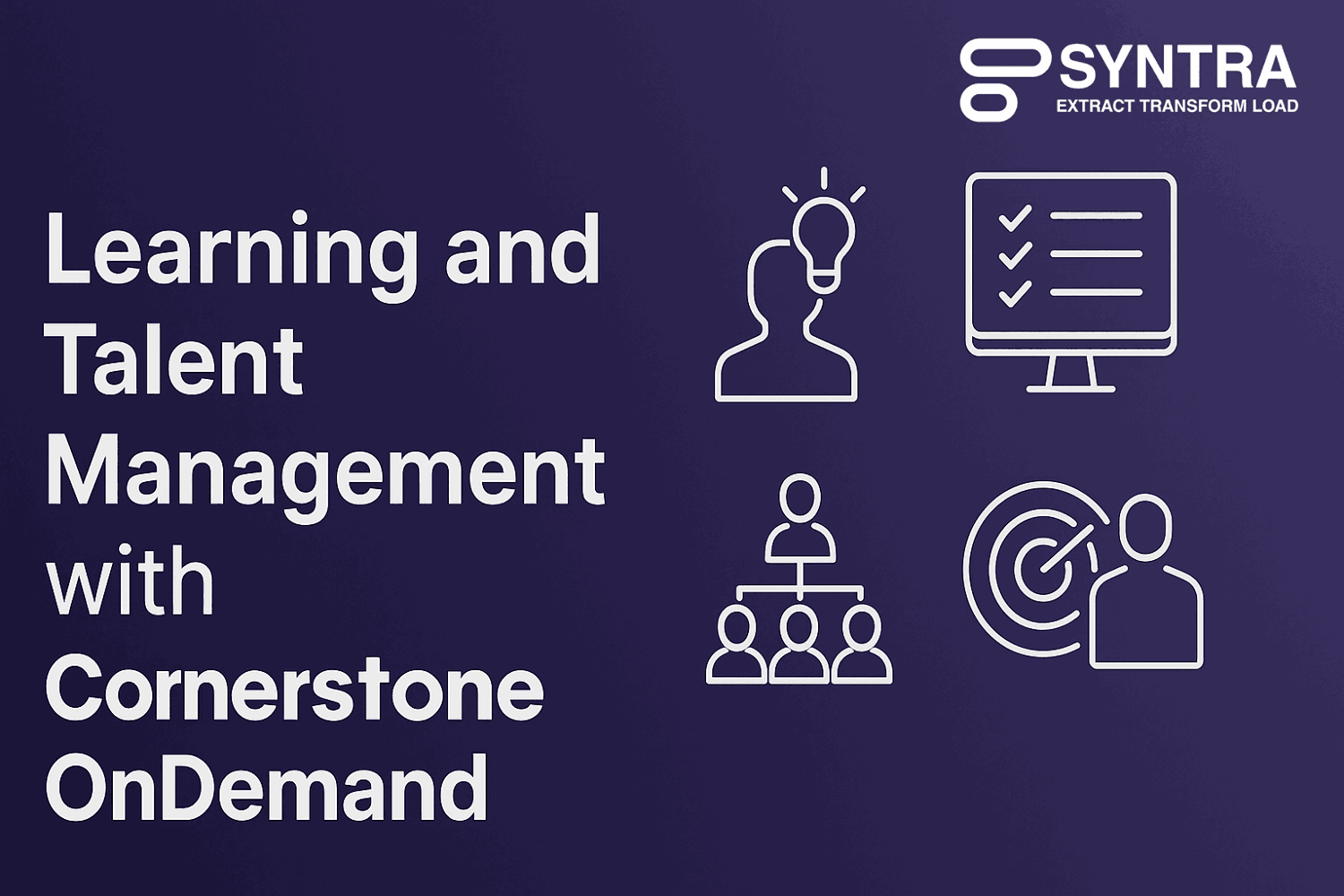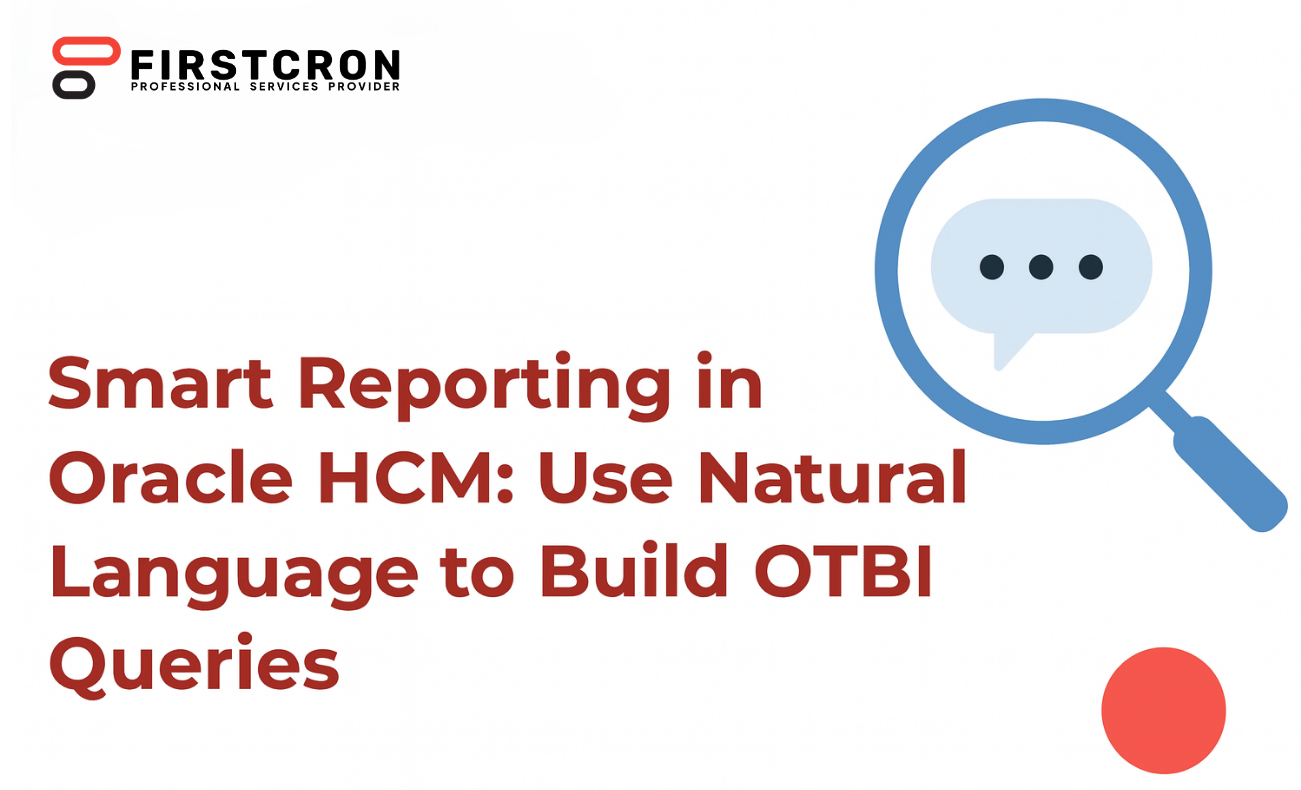
Modern vendor management and workforce systems live or die by the quality, timeliness, and consistency of their people data. When payroll is processed in ADP and core HR and downstream financials are managed in Oracle Fusion, every recruiting milestone, job change, tax update, or costing tweak becomes a data handshake across platforms. If those handshakes fail, it shows up instantly: delayed payrolls, rework for HR ops, reconciliation headaches for finance, and compliance exposure for leadership. That is the practical backdrop for Syntra—a focused extract, transform, and load (ETL) accelerator purpose-built to move core HR and payroll data from ADP into Oracle Fusion with the least human effort and the greatest operational reliability. Recent industry write-ups emphasize that Syntra’s advantage is its specialization: it understands the semantics of employee master data, compensation elements, taxation, time, and costing and shapes them to what Oracle Fusion expects, removing common causes of load failure and manual clean-up that generic middleware often leaves behind.
Syntra’s design is pragmatic rather than ornamental. It extracts the right data from ADP, applies mapping, validation, and formatting rules that reflect Oracle Fusion’s canonical structures, and then loads the results with visibility and control. That governed approach matters because human-capital data is both stateful and regulated: a mistyped earning code or an unmapped deduction can cascade into incorrect net pay, incomplete costing, or faulty tax reporting. FirstCron’s descriptions of Syntra repeatedly call out these safeguards—pre-load checks, rule-driven mappings, and attention to common failure points—so that HR and payroll teams spend time fixing real upstream issues instead of wrestling with interface errors.
In this blog we’ll cover
Syntra’s Role In An ADP Via Oracle Fusion Estate
In enterprises where Oracle Fusion serves as the system of record for organizations, jobs, positions, and financials, and ADP runs payroll, the integration surface is both wide and dynamic. Oracle itself supports patterns for ADP connectivity, but the practical challenge is normalizing real-world data variations and getting them into Fusion’s loader formats reliably, week after week, cycle after cycle. Syntra sits precisely in that middle, translating ADP’s schemas and codes into the structures—like worker, assignment, element entry, and costing—that Oracle Fusion Loaders and REST APIs accept, while honoring the cadence of payroll cycles and the governance needs of finance and compliance teams. This is not just about moving files; it is about preserving intent across systems so the “meaning” of pay, benefits, or tax setup remains intact end-to-end. Documentation from both Oracle and ADP highlights the importance of structured, near-real-time or batch integrations for new hires, changes, and payroll events; Syntra complements those patterns by doing the heavy lifting in transformation so that the loads are right the first time.
Performance really matters in payroll. U.S. environments run on tight timetables with statutory reporting that tolerates no slippage. When inbound data is malformed or incomplete, entire payroll runs can stall. Analyses of Syntra’s deployments in the U.S. payroll landscape underscore how a specialized ETL layer eliminates those delays by focusing on the exact objects that trigger errors—like mismatched earning codes, missing position mappings, or inconsistent location and tax profiles—before the data ever hits Fusion’s loaders. The result is fewer reruns, fewer off-cycle fixes, and measurably smoother closes for finance.
High-value HR And Payroll Objects That Benefit From Transformation
Employee and worker master data is the first place transformation pays dividends. ADP’s representation of a person, along with identifiers, names, demographics, and employment status, must map cleanly to Oracle’s Person and Employment model. Even small divergences—like status codes or name formats—can block downstream actions. Syntra normalizes these fields, ensures identifier uniqueness, and aligns employment statuses so that subsequent loads, such as assignments or payroll elements, can attach to the correct record without manual intervention. In the same motion, the platform ensures that key dates—hire, rehire, termination—are aligned to Fusion’s effective-dating logic, keeping history coherent for audits and reports. Commentary from FirstCron repeatedly ties Syntra’s benefits to these foundational data alignments, because everything else in payroll depends on them.
Assignments, jobs, and positions are the next critical tier. Oracle Fusion makes extensive use of job and position hierarchies, grades and grade rates, and assignment attributes to drive eligibility, costing, and approvals. ADP may house equivalent information in different constructs or codes. Syntra’s mapping layer reconciles those differences, converting ADP job titles and codes into valid Fusion Jobs and Positions, linking grades where applicable, and setting assignment metadata—FTE, working hours, and legal employer—so that downstream payroll calculations and costing are accurate. By cleaning and enriching this structural data en route, Syntra removes the most common cause of failed loads: reference data mismatch. FirstCron’s Syntra articles stress that this normalization saves days of cutover effort and prevents recurring defects after go-live.
Compensation and element entries are where the stakes get tangible. Pay runs succeed or fail based on the alignment of earning, deduction, and benefit codes between ADP and Oracle Fusion. Syntra translates ADP earning codes to Oracle elements, ensures input values conform to the target element definitions, and validates proration and frequency rules. It also curates defaulting logic for benefits and deductions, ensuring, for example, that pre-tax and post-tax designations carry over, and that arrears or retro components are flagged appropriately. Because these are the entries that actually hit the general ledger via costing, Syntra’s checks reduce the risk of mispostings and the painful reclassifications that follow. Thought leadership around Syntra notes that this domain—compensation and payroll elements—is where a specialized ETL shines compared to generalized iPaaS tooling.
Time, absence, and attendance data commonly spans systems, especially when a workforce management tool sits alongside ADP. Syntra standardizes time categories and absence reasons so that the hours landing in Oracle Fusion match payroll element expectations and accrual rules. This includes reconciling timecard units, rounding practices, and leave balances so they do not break eligibility checks or create unexplained variances in net pay. For vendor-heavy workforces—think BPOs, staffing partners, or EOR providers—those conversions are essential for consistent billing, program-level SLA tracking, and accurate vendor scorecards. FirstCron’s recent pieces extend Syntra’s applicability to EOR and multi-payroll landscapes, showing how a single ETL layer can normalize time and employment flows across multiple providers and still deliver one clean payload to Fusion.
Costing, ledger mapping, and organizational anchors—departments, legal employers, business units, and locations—round out the objects that most often require careful transformation. ADP can store cost distribution as percentages against departments or custom fields; Oracle Fusion expects cost allocation keyed to accounting flexfields or cost centers. Syntra translates and validates these allocations, ensures that every costing segment has a valid target value, and prevents suspense postings. In parallel, it reconciles organization codes and locations so that approvals, security profiles, and analytics work as designed in Fusion. These steps pay back immediately at month end, when finance needs precise labor distribution and when vendor management must compare contract terms to actuals without manual reconciliation.
How This Transformation Reduces Time And Effort Across The Workforce Lifecycle
The cumulative effect of these conversions is time returned to the teams who need it most. HR operations stop firefighting data errors and return to service-level work. Payroll administrators run fewer re-calculations and off-cycles. Finance closes faster because costing lands correctly the first time. Vendor managers gain a single, reliable view of labor, cost, and compliance across staffing partners and geographies, instead of stitching together spreadsheets from different sources. Industry commentary points out that in the U.S., where payroll deadlines and tax submissions are rigid, this reliability prevents downstream penalties and reputational risk. And because Syntra is built around repeatable mappings and validations, organizations also cut effort during acquisitions, divestitures, or new vendor onboardings; the ETL patterns simply extend to the new data sources with governed rules rather than bespoke scripts.
Equally important, Syntra’s approach coexists with the broader Oracle and ADP ecosystems rather than replacing them. Oracle provides supported pathways for ADP integration, and ADP and partners offer marketplace connectors; Syntra adds an opinionated transformation layer that respects those endpoints but eliminates day-to-day data wrangling. That is why it fits teams that need both speed and assurance: it shortens time-to-value during implementation and keeps operations steady afterward. Combining Oracle’s native integration patterns with Syntra’s ETL discipline yields a stack that is not only technically sound but operationally forgiving—the data gets where it needs to go, in the shape that downstream processes require, no matter how many vendors or payrolls sit upstream.
The Bottom Line For Vendor Management And Workforce Programs
Vendor management and workforce systems succeed when they reduce friction between people operations, payroll execution, and financial accountability. Syntra contributes by removing the single most stubborn friction point: transforming real-world HR and payroll data from ADP into Oracle Fusion’s precise models without excessive human effort. By focusing on the objects that matter—person and employment records, assignments and positions, elements and costing, time and absence, and the organizational scaffolding that binds them—Syntra makes high-stakes, time-bound processes dependable. The practical wins are immediate: fewer failed loads, faster payroll cycles, and cleaner financials; the strategic wins compound over time as teams onboard new vendors or geographies with confidence. For organizations that run payroll in ADP and orchestrate the rest of the workforce lifecycle in Oracle Fusion, a specialized ETL layer is not a luxury; it is the backbone that keeps vendor relationships honest, labor economics transparent, and compliance continuous. Recent coverage shows Syntra filling that role with discipline and clarity, making the vendor management and workforce system not just connected, but truly coherent.
Tags
Related Post
Navigating Oracle Fusion HCM & Payroll Patch 25C: Key Issues And Solutions For UK Local Councils
July 26th, 2025 10 min read
7 Reasons Why Companies Are Moving From Taleo To Oracle Recruiting Cloud
June 2nd, 2025 14 min read
7 Proven Oracle Fusion Testing Principles To Guarantee Defect-Free Cloud Deployments
May 16th, 2025 15 min read
Navigating Oracle Fusion HCM & Payroll Patch 25A: Key Considerations For UK Local Councils
July 27th, 2025 10 min read
Driving Compliance And Security With Smart Testing In Oracle Fusion
June 5th, 2025 9 min read
WEEKEND READS
Navigating Oracle Fusion HCM & Payroll Patch 25C: Key Issues And Solutions For UK Local Councils
July 26th, 2025 10 min read
7 Reasons Why Companies Are Moving From Taleo To Oracle Recruiting Cloud
June 2nd, 2025 14 min read
Navigating Oracle Fusion HCM & Payroll Patch 25A: Key Considerations For UK Local Councils
July 27th, 2025 10 min read
How End-to-End Testing Of Oracle Fusion Enhances Operational Efficiency In Banking
May 23rd, 2025 11 min read
Learning And Talent Management With Cornerstone OnDemand
October 10th, 2025 17 min read
Smart Onboarding Journeys With AI: Personalized Employee Integration Through Oracle HCM Core And Learning
September 13th, 2025 21 min read
UKG (Ultimate/Kronos) — USA And Global, Legacy-to-Modern Workforce Management
October 5th, 2025 23 min read
Data Migration Best Practices: From Taleo To Oracle Recruiting Cloud
May 28th, 2025 13 min read
Smart Reporting In Oracle HCM: Use Natural Language To Build OTBI Queries
August 17th, 2025 20 min read

















